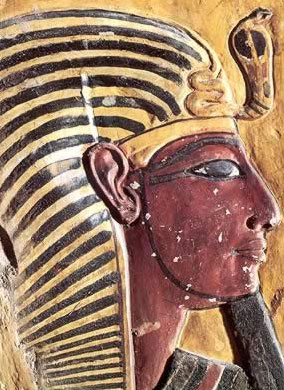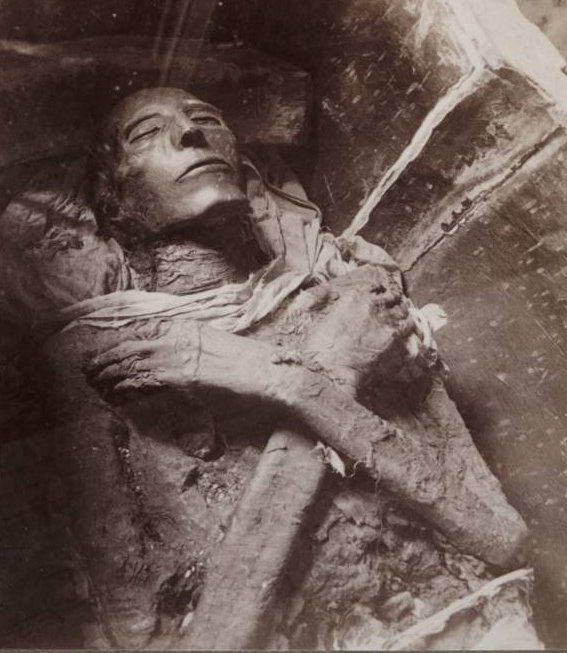
Seti I was the son of Ramses I (More commonly known as Ramesses I, meaning “Born of Ra”) and Sitre (“Daughter of Re”) and was born in the year 1323 BC and died in 1279 BC[1], in Avaris, Egypt.
He was the husband of Queen Tuya, and had four children with her, which of these included Tia, Ramses II, Henutmire and Thermuthis. his birth name (Seti) means ‘He of the god Seth, beloved of Ptah’. To the Greeks, he was Sethos I, and his throne name was Menmaatre, meaning ‘Eternal is the Justice of Re’.[2]
The exact duration of Seti I’s reign is unknown. The reason being is because Egyptian Pharaohs frequently changed the dates of previous reigns to remove unpopular pharaohs from history.[3] Most historians believe that the reign went from 1290 BC and ending around 1279 BC.
Other estimates of this vary from 5 to 10 years. Historians do not know when Seti I reigned, they do know what he did during his reign. During Seti I’s time on the throne, he did several things that impacted Ancient Egypt’s way of living. Seti did many things to increase Ancient Egypt’s prosperity, he was also a great builder, building many different monuments in his reign and greatly expanded the lands of Ancient Egypt.
Seti I did many things to increase the prosperity of Egypt. He opened new mines and quarries for stone and precious metals that could be turned into statues and obelisks. He also dug wells and also rebuilt temples and shrines that had been damaged or fallen into decay. He also continued to work on the hypostyle hall at Karnak, which had been started by his father, Ramses I, which is noted as one of the most impressive monuments in Egyptian history.[4]
As well as the hypostyle hall in Karnak, Seti I also made quite a number of other buildings. Some of them include the Temple of Seti at Abydos, which was considered an important building in Ancient Egyptian times and was dedicated to several gods, including Osiris, Isis, Horus, Amen-Re, Ptah and Re-Harakhte.
The temple was also dedicated to himself. Behind this temple is another building, which is dedicated to Osiris. This building is called the Osireion.
Other structures made by Seti I include, the Mortuary Temple at Qurna which is in Thebes, the temple at Elephantine, and the minor temples that he created, such as the temple at Buhen, which honored all the gods, the desert temple north of Edfu, and temples that were dedicated to his biological father. Some temples were also dedicated to himself as well as the gods, so he could prove to the people that he had a close connection to the gods, and therefore, gained the trust of the Egyptian population.
Another structure that Seti I made in his reign was his very own tomb. By historians and archaeologists, the tomb is called KV17. Other names include “Belzoni’s tomb”, “the Tomb of Apis”, and “the Tomb of Psammis, son of Nechois”. Seti I’s tomb is located in the Valley of Kings.[5]
The tomb was discovered in 187 by Giovanni Battista Belzoni.[6] When Belzoni excavated the tomb, he noted that the length of the tomb was about 100 meters.
But in recent excavations, archaeologists have found that the tomb was much longer than thought, and was 136 meters when measured.[7] The layout of the tomb is as follows.
A descending flight of steps leads to the entrance to the tomb, which then leads to a corridor and then a second stairway.
After the second corridor is a rectangular shaft leading into an 8-meter-wide room containing four large pillars to which a second hall is attached. Further on lies a more complex hall containing six pillars and two chapels.
The burial chamber is as follows: The ceilings are decorated with constellations and the walls are adorned with passages from the Book of Gates and the Amduat. All throughout the tomb the impressive art which the reign of Seti I was renowned for is found. The alabaster sarcophagus in the burial chamber contained the mummy of Seti I.[8]
Seti I expanded the areas of Ancient Egypt, especially in the east, and restored the empire to where it was in the 18th dynasty. His main priority was to re-establish power over Canaan and Syria. He had also had earned multiple titles before actually becoming king, these include troop commander, vizier, and lead archer.
These titles show that Seti I was a skilled man with knowledge in battle. Seti I also battled in northern Palestine, several times, he battled the Hittites and fought at least one battle with the Hittite king Muwatallis. Most of Seti I’s military campaigns ended in victory, and the memories of the victories are remembered with scenes of the military campaigns of Seti.[9]
Seti I is regarded as one of the most important pharaohs in Ancient Egyptian history, because of the many things he achieved in his reign. He was a large impact on the Ancient Egyptian community, gaining more land for the country, making more temples and fixing the ones that were decaying, and increasing the prosperity of the land.
Overall, he was very important to Ancient Egypt and its people, being a very big help to the people of Ancient Egypt. He was also the father of Rameses II, who would be his successor and a very famous pharaoh.
BIOGRAPHY
[1] Philip Steele, Step into… Ancient Egypt, Anness Publishing, Vancouver, pg.26
[2] Tour Egypt, Seti (Sethos) I, Retrieved 30/04/17, <http://www.touregypt.net/featurestories/seti.htm>
[3] Ancient Egypt Online, Seti I- Blurring of Dates, November 2015, Dirk Laukens, Retrieved 26/04/17, <http://www.ancient-egypt-online.com/seti-I.html>
[4] Encyclopedia Britannica, Seti I, October 23, 2008, Editors from Encyclopedia Britannica, Retrieved 26/04/17, < https://www.britannica.com/biography/Seti-I>
[5] Ask Aladdin, Egyptian Tombs, Retrieved 30/04/17, <http://www.ask-aladdin.com/Egypt-Sites/Egypt-tombs/seti-i.html>
[6] Weldon Owen Inc, Insiders-Egypt 1st edition, Published 2007, Simon & Schuster Books for Young Readers, Sydney, pg. 46
[7] National Geographic News, Pharaoh Seti I’s Tomb Bigger Than Thought, Page 1, Retrieved 24/04/17, < http://news.nationalgeographic.com/news/2008/04/080417-seti-tomb.html>
[8] The Roles and Contributions of Seti I, Tomb of Seti, Contributions as a Builder, Retrieved 24/04/17 < http://therolesandcontributionsofsetii.weebly.com/builder.html>
[9] David Kennett, Pharaoh- Life and death of a god, 1st edition, Scholastic/Omnibus Books, Gosford, 2008, pg. 19


Cool tanks
thanks very much